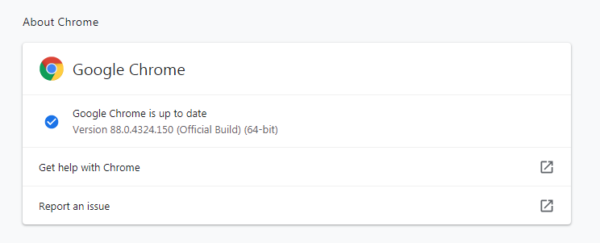Update now! Chrome patches zero-day that was exploited in the wild
A Chrome patch has been issued with an advisory stating that the Stable channel has been updated to 88.0.4324.150 for Windows, Mac and Linux. The only noteworthy thing about this update is a patch for a zero-day vulnerability that has been actively exploited in the wild. But that one looks to be extremely important.
Which zero-day got patched?
Publicly disclosed computer security flaws are listed in the Common Vulnerabilities and Exposures (CVE) database. Its goal is to make it easier to share data across separate vulnerability capabilities (tools, databases, and services). This zero-day got listed as CVE-2021-21148. From the update announcement for this Chrome patch we can learn that the patch counters a heap buffer overflow in the V8 JavaScript engine, reported by Mattias Buelens on January 24, 2021.
What is a heap buffer overflow?
Heap is the name for a region of a process’ memory which is used to store dynamic variables. A buffer overflow is a type of software vulnerability that exists when an area of memory within a software application reaches its address boundary and writes into an adjacent memory region. In software exploit code, two common areas that are targeted for overflows are the stack and the heap.
So, by creating a specially crafted input, attackers could use this vulnerability to write code into a memory location where they normally wouldn’t have access. Having this attack vector available as a zero-day in a popular browser is a golden opportunity for a watering hole.
Watering holes are used as a targeted attack strategy. The attackers infect a website where they know their intended victim(s) will visit, or lure them to a site of their own making. Depending on the nature of the infection, the attackers can single out their intended target(s) or just infect anyone that visits the site unprotected. The watering hole strategy is a mix of social engineering, hacking, and drive-by infections that requires a high level of knowledge and a well-thought-out strategy.
How was this vulnerability used in the wild?
Based on the timing of the discovery (January 24) and this report by Google’s Threat Analysis Group (TAG) issued on January 26, the general assumption is that the attack was used against security researchers working on vulnerability research and development at different companies and organizations. To connect and gain trust among security researchers, the actors created a research blog and multiple Twitter profiles to interact with potential targets.
One of the methods the attackers used was to interact with the researchers and get them to follow a link on Twitter to a write-up hosted on a malicious website. Shortly after the visit, a malicious service was installed on the researcher’s system and an in-memory backdoor would begin to communicate with a command and control (C&C) server. This sure sounds like something that could be accomplished using a heap buffer overflow in a browser.
The update
Despite its discovery, this exploit remains useful to cybercriminals. We advise everyone to update and get the latest version of Chrome as soon as possible.
The easiest way to do it is to allow Chrome to update automatically, which basically uses the same method as outlined below but does not require your attention. But you can end up lagging behind if you never close the browser or if something goes wrong, such as an extension stopping you from updating the browser.
So, it doesn’t hurt to check now and then. And now would be a good time, given the zero-day vulnerability. My preferred method is to have Chrome open the page chrome://settings/help which you can also find by clicking Settings > About Chrome.
If there is an update available, Chrome will notify you and start downloading it. Then it will tell you all you have to do to complete the update is Relaunch the browser.

Stay safe, everyone!
The post Update now! Chrome patches zero-day that was exploited in the wild appeared first on Malwarebytes Labs.
If you like the site, please consider joining the telegram channel or supporting us on Patreon using the button below.



![Cobalt Strike Beacon Detected - 15[.]229[.]22[.]115:443 4 Cobalt-Strike](https://www.redpacketsecurity.com/wp-content/uploads/2021/11/Cobalt-Strike-300x201.jpg)
